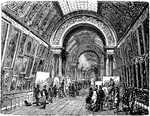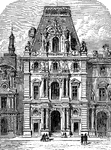Clipart tagged: ‘louvre’

Akroter Eagle
The Akroter Eagle is shown at the Flora Pavillion in the Louvre in Paris, France. It was designed by…
![The Musée du Louvre or officially the Grand Louvre — in English, the Louvre Museum or Great Louvre, or simply the Louvre — is the national museum of France, the most visited museum in the world, and a historic monument. It is a central landmark of Paris, located on the Right Bank of the Seine in the 1st arrondissement (neighborhood). Nearly 35,000 objects from the 6th century BC to the 19th century are exhibited over an area of 60,600 square meters (652,300 square feet)."Du Cerceau, who flourished during the reign of Henry IV., connected the block of buildings which belong to the Louvre, and had been constructed under Catherine dei Medici, by a gallery with the Tuileries [shown here]. This architect abandoned the characteristic feature of the French Renaissance, which had prevailed hitherto, namely, of giving its peculiar columnar order to each storey, and assimilated his designs to those of the late Roman Renaissance, in which a striking effect was produced at the expense of truth by continuous columns and pilasters extending over several storeys and rows of windows."](https://etc.usf.edu/clipart/73700/73745/73745_flore_pavili_mth.gif)
Flore Pavilion and part of the Gallery of the Louvre
The Musée du Louvre or officially the Grand Louvre — in English, the Louvre Museum or Great Louvre,…
![The Musée du Louvre or officially the Grand Louvre — in English, the Louvre Museum or Great Louvre, or simply the Louvre — is the national museum of France, the most visited museum in the world, and a historic monument. It is a central landmark of Paris, located on the Right Bank of the Seine in the 1st arrondissement (neighborhood). Nearly 35,000 objects from the 6th century BC to the 19th century are exhibited over an area of 60,600 square meters (652,300 square feet).Charles Le Brun (February 24 1619 – February 22 1690) was a French painter and art theorist, one of the dominant artists in 17th century France."Little by little a method of ornamentation was introduced by successive decorators and architects, which was eminently suited to the French taste. Androuet Du Cercean and Jean Lepautre are especially noticeable as representatives of this school of establishment. The sumptuous Apollo Gallery in the Louvre is a characteristic example of the productions of the latter. [This image] exhibits a portion of the system of decoration which pervades the whole gallery."](https://etc.usf.edu/clipart/73700/73725/73725_lebrun_charl_mth.gif)
Fragment from the Apollo Gallery in the Louvre at Paris
The Musée du Louvre or officially the Grand Louvre — in English, the Louvre Museum or Great Louvre,…

Louvre West Pavilion
"Louvre is the name of a celebrated public building of Paris, situated in the N. part of the city, near…

Bird's Eye View of the Louvre
An illustration of the Louvre Museum in Paris, France from a bird's-eye view. The Louvre is one of the…
!["The change from the pure to the later Renaissance, which was formerly seen only in individual instances, has now received a certain extension. This is mainly owing to the key-note struck in the New Louvre [shown here], begun by Visconti, but finished by another architect. Although it is true that the new building conforms in general to the architecture of the Old Louvre, yet still an increase rather than a decrease is to be perceived in the effort for picturesque effect, in the licence of the Roccoco style, and in an unstructural treatment of the individual forms and ornamental parts."](https://etc.usf.edu/clipart/73800/73804/73804_louvre_corne_mth.gif)
Corner Pavilion of the New Louvre
"The change from the pure to the later Renaissance, which was formerly seen only in individual instances,…
![The Musée du Louvre or officially the Grand Louvre — in English, the Louvre Museum or Great Louvre, or simply the Louvre — is the national museum of France, the most visited museum in the world, and a historic monument. It is a central landmark of Paris, located on the Right Bank of the Seine in the 1st arrondissement (neighborhood). Nearly 35,000 objects from the 6th century BC to the 19th century are exhibited over an area of 60,600 square meters (652,300 square feet).The Louvre was built by "three prominent architects, [one of which was] Pierre Lescot (1510-1578), who desiged the celebrated Western Façade of the Louvre [shown here]."](https://etc.usf.edu/clipart/73700/73722/73722_louvre_facad_mth.gif)
Inner Façade of the Louvre
The Musée du Louvre or officially the Grand Louvre — in English, the Louvre Museum or Great Louvre,…
![The Musée du Louvre or officially the Grand Louvre — in English, the Louvre Museum or Great Louvre, or simply the Louvre — is the national museum of France, the most visited museum in the world, and a historic monument. It is a central landmark of Paris, located on the Right Bank of the Seine in the 1st arrondissement (neighborhood). Nearly 35,000 objects from the 6th century BC to the 19th century are exhibited over an area of 60,600 square meters (652,300 square feet).The Louvre was built by "three prominent architects, [one of which was] Pierre Lescot (1510-1578), who desiged the celebrated Western Façade of the Louvre [shown here]."](https://etc.usf.edu/clipart/73700/73723/73723_louvre_facad_mth.gif)
Inner Façade of the Louvre
The Musée du Louvre or officially the Grand Louvre — in English, the Louvre Museum or Great Louvre,…

Gallery in the Louvre
An illustration of one of the galleries in the Louvre in Paris, France. The Louvre is one of the world's…

The Richelieu Pavilion of the Louvre
The Richelieu Pavilion (a pavilion located on the inside "court") of the Louvre Palace. The Richelieu…

The Lion of Lucerne
"It represents a dying lion, which, pierced by a lance, still guards with its paw the Bourbon lilies.…
![The Musée du Louvre or officially the Grand Louvre — in English, the Louvre Museum or Great Louvre, or simply the Louvre — is the national museum of France, the most visited museum in the world, and a historic monument. It is a central landmark of Paris, located on the Right Bank of the Seine in the 1st arrondissement (neighborhood). Nearly 35,000 objects from the 6th century BC to the 19th century are exhibited over an area of 60,600 square meters (652,300 square feet)."Du Cerceau, who flourished during the reign of Henry IV., connected the block of buildings which belong to the Louvre, and had been constructed under Catherine dei Medici, by a gallery with the Tuileries. This architect abandoned the characteristic feature of the French Renaissance, which had prevailed hitherto, namely, of giving its peculiar columnar order to each storey, and assimilated his designs to those of the late Roman Renaissance, in which a striking effect was produced at the expense of truth by continuous columns and pilasters extending over several storeys and rows of windows.Although Du Cerceau was obligated to leave France in the year 1604, the impulse which he had given in the direction of the above-mentioned manner led to its being generally adopted. The new buildings were more correct, but less picturesque than those built during the earlier period of the French Renaissance, and a certain insipidity seems to characterize the various structures erected during the reigns of Henry IV., and especially Louis XIII. As is shown [here], a combination of free-stone and brick was restored to in such a way that the former was employed for the mouldings, and for the quoins and dressings of the doors and windows, whilst brick was used for the spaces between. In the case of the windows the free-stone introduced assumed the forms of quoins. If ornamentation had been previously excessive, it now retired into the background, and was only employed in moderation; and the method of its treatment began to be distinguished from that of the former period. The forms of the details above all began to lose in purity: rustications were inappropriately introduced in the walls and columns, and the roofs were made high and steep, which gave the rest of the building a heavy and squat appearance, whilst the numerous turret-shaped chimneys, which were necessitated by these high roofs, formed a peculiar feature in the construction."](https://etc.usf.edu/clipart/73700/73746/73746_royal_palace_mth.gif)
Paris, Royal Palace Façade
The Musée du Louvre or officially the Grand Louvre — in English, the Louvre Museum or Great Louvre,…

Louvre Torus Moulding
The Louvre Torus Moulding is a French Renaissance design of foliage. It is found in the Louvre museum…

Louvre Torus Moulding
The Louvre Torus Moulding is a French Renaissance design of foliage. It is found in the Louvre museum…

Louvre Torus Moulding
The Louvre Torus Moulding is a French Renaissance design of foliage. It is found in the Louvre museum…
![The Musée du Louvre or officially the Grand Louvre — in English, the Louvre Museum or Great Louvre, or simply the Louvre — is the national museum of France, the most visited museum in the world, and a historic monument. It is a central landmark of Paris, located on the Right Bank of the Seine in the 1st arrondissement (neighborhood). Nearly 35,000 objects from the 6th century BC to the 19th century are exhibited over an area of 60,600 square meters (652,300 square feet).The three prominent architects, Pierre Lescot (1510-1578), who desiged the celebrated Western Façade of the Louvre, Philibert Delorme and Jean Buillant, who was the architect of the earlier portions of the Tuileries [shown here], and of the Château d'Ecouen, exerted such an influence over the architecture of their native country that the Italian Renaissance Style became thenceforward the predominant one in France."](https://etc.usf.edu/clipart/73700/73724/73724_tuileries_fa_mth.gif)
Façade of the Tuileries
The Musée du Louvre or officially the Grand Louvre — in English, the Louvre Museum or Great Louvre,…









